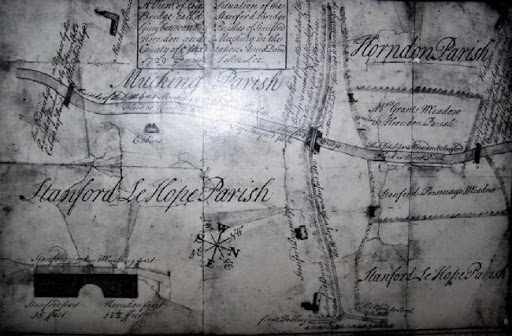The Early Times
As is well known, extensive archaeological excavations at Mucking in the 1960’s and 70’s revealed the presence of humans in the area as far back as the New Stone Age some 6,000 years ago. Much more recent excavations at Stanford Wharf Nature reserve by Edward Biddulph and his team from Oxford University also demonstrated evidence of human habitation in the middle Iron Age some 2300 years ago. Fragments of pottery from this time were found by the team and also the earliest tentative evidence of salt extraction.
This activity was of considerable importance and many so called Red Hill sites where salt extraction took place have been identified by archaeologists around the Essex coast. The area grew in importance after the Roman Conquest in 54BC with substantial trade to the growing area of London. Salt production expanded due to the availability of peat as a fuel to evaporate the brine that had been collected in channels after flood tide. Salt extraction continued until around the fourth century but with the general rise in the level of the Thames, the area around the wharf became increasingly marshy and difficult to work and the extraction appears to have been abandoned.
The north bank of the Thames was amongst the earliest areas to be settled by the Saxons during their main invasions in the fifth and sixth centuries. It is not certain what happened to the original Celtic Britons who had inhabited the area both before and after the Roman era, but it seems likely that they were displaced by the newcomers in a general move westwards. Many villages in the south Thameside area derive their present day names from these Saxon settlers, Fobba; Curra; Hassa; Mucca; Tilla and Wocca.
Essex became the Kingdom of the East Saxons, one of the seven Anglo Saxon kingdoms known as the Heptarchy by the gradual integration of the various tribal groups such as Hassa’s and Curra’s.
The Venerable Bede, a monk and scholar who lived from 672 to 735 AD, stated in his historical works that in 604 AD the Kingdom was ruled by King Sebert. The Kingdom of Essex was not of great historical importance although it did flourish for a few hundred years and included most of the land of the Middle Saxons now Middlesex and also Hertfordshire but was usually subservient to the more important Saxon Kingdoms of Mercia; Kent or Wessex. The lands of 3 the Middle Saxons and Hertfordshire were ceded to the King of Mercia in the 8th century to leave the kingdom with the boundary of the county of Essex as it existed until the 20th century.
Finally in 825 AD the Kingdom of Essex was ceded by King Segered to Egbert, King of Wessex. The Saxon settlement here became known as Hassinghebroc. P.H Reaney in his book ‘The Place-Names of Essex’ published in 1935, defines this as ‘the brook of the people of Hassa.’ The genesis of the later name Stanford-le-Hope remains uncertain. Stanford certainly refers to the original stone ford across the rivulet known locally as the ‘Hope River’ or the ‘Hassing Brook.’ The ford was replaced by a bridge that marked the original boundaries of the parishes of Stanford, Mucking, and Horndon-on-the-Hill. The current bridge in London Road dates from 1924.
A map with the title “A view of the situation of the bridge known as Stanford Bridge lying between the Parishes of Stanford Horndon and Mucking in the county of Essex taken Anno Domini 1729”
Philip Morant in his opus “The History and Antiquities of the County of Essex” published in 1768 states that Le hope is added to Stanford to distinguish the parish from that of Stanford Rivers also in Essex. A “hop” in Old Norse being defined as “a small land-locked bay or inlet, salt at flood-tide and fresh at ebb” The hope referred to in this case is the “Lower Hope at the mouth of the River Thames at East Tilbury a station for ships in the mouth of the river below Gravesend.” Morant also cites the “learned Mr. Camden” who states that ‘Hope signifies the side of a hill’ or an area bounded by or ‘hooped’ in hills.
The ‘le’ could either have had its origins as the French masculine definite article ‘the’ owing to the Normans’ practice of Gallicising Saxon names, or it could mean ‘near the Hope’ or ‘on the Hope’. It could further have been a contraction of the Saxon ‘lee’ meaning meadow or pasture land. By this reasoning the name Stanford-le-Hope would actually be a description that would signify an area of meadows by a stream with a stone ford and bounded by hills these being the high ground of Horndon and Laindon to the north.
These and other accounts of the origin of the name are given in the Reverend William Palin’s essay “Stifford and Its Neighbourhood” published in 1871 where he observes that it “has been as much disputed as Homer’s birthplace.”
A further explanation is given by local historian Christopher Harrold in his book ‘Exploring Thurrock’ Mr Harrold notes the name Hasinghebroc as meaning the ‘low marshy ground of Hassa’s people’ He suggests that the name probably evolved into the “low marshy ground with a stone ford” “enclosures of land in south east England being known as hopes, hop having the same meaning in topography as Broc.”
It has been suggested by Morant and others that there were once two distinct hamlets in the area known as Stanford and Hassingbroke as there was a free chapel, the Chapel of St. Nicholas endowed with fourteen acres of glebe land and tithes from Abbotts Manor.
